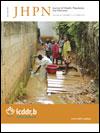Vitamin D Status of Infants in Northeastern Rural Bangladesh: Preliminary Observations and a Review of Potential Determinants
DOI:
https://doi.org/10.3329/jhpn.v28i5.6154Keywords:
Risk factors, 25-hydroxyvitamin D, Vitamin D, Vitamin D deficiency, BangladeshAbstract
Vitamin D deficiency is a global public-health concern, even in tropical regions where the risk of deficiency was previously assumed to be low due to cutaneous vitamin D synthesis stimulated by exposure to sun. Poor vitamin D status, indicated by low serum concentrations of 25-hydroxyvitamin D [25(OH)D], has been observed in South Asian populations. However, limited information is available on the vitamin D status of young infants in this region. Therefore, to gain preliminary insights into the vitamin D status of infants in rural Bangladesh, 25(OH)D was assessed in a group of community-sampled control participants in a pneumonia case-control study in rural Sylhet, Bangladesh (25°N) during the winter dry season (January-February). Among 29 infants aged 1-6 months, the mean 25(OH)D was 36.7 nmol/L [95% confidence interval (CI) 30.2-43.2]. The proportion of infants with vitamin D deficiency defined by 25(OH)D <25 nmol/L was 28% (95% CI 10-45), 59% (95% CI 40-78) had 25(OH)D<40 nmol/L, and all were below 80 nmol/L. From one to six months, there was a positive correlation between age and 25(OH)D (Spearman=0.65; p=0.0001). Within a larger group of 74 infants and toddlers aged 1-17 months (cases and controls recruited for the pneumonia study), young age was the only significant risk factor for vitamin D deficiency [25(OH)D <25 nmol/L]. Since conservative maternal clothing practices (i.e. veiling) and low frequency of intake of foods from animal source (other than fish) were common among the mothers of the participants, determinants of low maternal-infant 25(OH)D in Bangladesh deserve more detailed consideration in future studies. In conclusion, the vitamin D status in young infants in rural Sylhet, Bangladesh, was poorer than might be expected based on geographic considerations. The causes and consequences of low 25(OH)D in infancy and early childhood in this setting remain to be established.
Key words: Risk factors; 25-hydroxyvitamin D; Vitamin D; Vitamin D deficiency; Bangladesh
DOI: 10.3329/jhpn.v28i5.6154
J HEALTH POPUL NUTR 2010 Oct;28(5):458-469
Downloads
257
207

